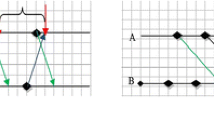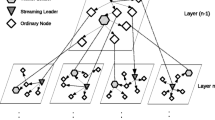Abstract
With the rapid growth of wireless communication technology, the availability of highly flexible and video-friendly mobile terminal platforms (such as smartphones and tablets), the emergence of major video content providers (like YouTube, Ustream, and PPTV, which provide a large catalog of attractive contents), Peer-to-Peer (P2P) live video streaming over the wireless and Internet is becoming more and more attractive to users. One of the main challenges is to provide a good quality of service though the dynamic behavior of the network. Traditionally, tree-based model uses a push method, that broadcaster transfers data to other users. This model has low start-up delay. However, there are two main problems in this method: if the bandwidth of an internal node is low, children nodes may lose data and when an internal node failure, other nodes can’t receive data until completing the recovery of the tree. On the other hand, mesh-based model uses a pull method, has low bandwidth of a neighbor node by pulling necessary data from a number of neighbor nodes. However, mesh-based model requires large buffers to support pull data from neighbor peers and there is an adjustment between minimum delay by sending pull request and overhead of whole system. So, both models have their own strengths and weaknesses. This paper proposes a new hybrid push-pull live P2P video streaming protocol called MobileCast that combines the benefits of pull and push mechanisms for live video delivery. We present new topology for P2P network with more stable and provide better video streaming quality. Our main goal is to minimize the network end-to-end delay, startup time, overhead, packet loss compared to the pure mesh networks, pure tree networks and provide a good quality of service though the dynamic behavior of the network.








Similar content being viewed by others
References
Chang H, Jamin S, Wang W (2011) Live streaming with receiver-based peer-division multiplexing. IEEE/ACM Trans Networking 19(1):55–68
Cheng X, Liu J (2012) Exploring interest correlation for peer-to-peer socialized video sharing. ACM Trans Multimed Comput Commun Appl 8, no.1, article 5
Cho C, Tran-Thi-Thu H, Park S, Kim J (2014) An efficient P2P-based mobile social media delivery for real-time mobilecast. Int J Softw Eng Appl 8(2):151–158
Fan B, John C, Lui S, Chiu D-M (2009) The design trade-offs of BitTorrent-like file sharing protocols. IEEE/ACM Trans Networking 17(2):365–376
Ha TTT, Won Y, Kim J (2014) Topology and architecture design for peer to peer video live streaming system on mobile broadcasting social media. International Conference on Information Science and Applications (ICISA)
Liu B, Cui Y, Lu Y, Xue Y (2009) Locality-awareness in BitTorrent-like P2P applications. IEEE Trans Multimedia 11(3):361–371
Magharei N, Rejaie R (2009) PRIME: peer-to-peer receiver-driven mesh-based streaming. IEEE/ACM Trans Networking 17(4):1052–1065
Sanna M, Izquierdo E (2013) Live scalable video streaming on peer-to-peer overlays with network coding. IEEE Lat Am Trans 11(3):962–968
Venkataraman V, Yoshida K, Francis P (2006) Chunkyspread: heterogeneous unstructured tree-based peer-to-peer multicast. In: Proc. IEEE ICNP
Wu D, Liang Y, He J, Hei X (2013) Balancing performance and fairness in P2P live video systems. IEEE Trans Circuits Syst Video Technol 23(6):1029–1039
Xu C, Liu J, Wang H, Wang C (2012) Coordinate live streaming and storage sharing for social media content distribution. IEEE Trans Multimedia 14(6):1558–1565
Zhang X, Liu J, Li B, Yum T-SP (2005) Coolstreaming/DONet: adata-driven overlay network for peer-to-Peer live media streaming. In: Proc. INFOCOM
Acknowledgments
This research was supported by Chonnam National University and Basic Science Research Program through the National Research Foundation of Korea (NRF) funded by the Ministry of Education, Science and Technology (NRF-2013R1A1A2013740) and was partially supported by the IT R&D program of MSIP(Ministry of Science, ICT and Future Planning) / IITP(Institute for Information & Communications Technology Promotion) [12221-14-1001, Next Generation Network Computing Platform Testbed].
Author information
Authors and Affiliations
Corresponding author
Rights and permissions
About this article
Cite this article
Tran, H.T.T., Won, Y. & Kim, J. An efficient hybrid push-pull methodology for peer-to-peer video live streaming system on mobile broadcasting social media. Multimed Tools Appl 76, 2557–2568 (2017). https://doi.org/10.1007/s11042-016-3249-x
Received:
Revised:
Accepted:
Published:
Issue Date:
DOI: https://doi.org/10.1007/s11042-016-3249-x




